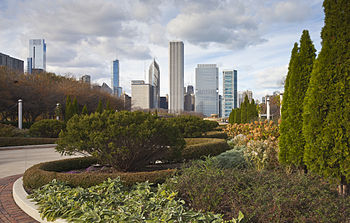Daley Bicentennial Plaza
|
Grant Park
|
|
 |
|
| Location | Chicago |
|---|---|
| Coordinates | 41°52′34″N 87°37′08″W / 41.876°N 87.6189°WCoordinates: 41°52′34″N 87°37′08″W / 41.876°N 87.6189°W |
| Area | Downtown Chicago |
| Architect | Edward H. Bennett |
| Architectural style | Beaux Arts, Art Deco |
| NRHP Reference # | 92001075 |
| Added to NRHP | July 21, 1993 |
Grant Park is a large urban park (319 acres or 1.29 km²) in the Loop community area of Chicago. Located in Chicago's central business district, the park's most notable features are Millennium Park, Buckingham Fountain, the Art Institute of Chicago and the Museum Campus. Originally known as Lake Park, and dating from the city's founding, it was renamed in 1901 to honor Ulysses S. Grant. The park's area has been expanded several times through land reclamation, and was the focus of several disputes in the late 19th century and early 20th century over open space use. It is bordered on the north by Randolph Street, on the south by Roosevelt Road and McFetridge Drive, on the west by Michigan Avenue and on the east by Lake Michigan. The park contains performance venues, gardens, art work, sporting, and harbor facilities. It hosts public gatherings, and several large annual events.
The park is often called "Chicago's front yard". It is governed by the Chicago Park District.
The original plans for the town of Chicago left the area east of Michigan Avenue unsubdivided and vacant, and purchasers of Michigan Avenue lots were promised that it would remain unoccupied. When the former Fort Dearborn Reserve became part of the townsite in 1839, the plan of the area east of Michigan Avenue south of Randolph was marked "Public ground. Forever to remain vacant of buildings."
The city officially designated the land as a park on April 29, 1844, naming it Lake Park. When the Illinois Central Railroad was built into Chicago in 1852, it was permitted to lay track along the lakefront on a causeway built offshore from the park. The resulting lagoon became stagnant, and was largely filled in 1871 with debris from the Great Chicago Fire, increasing the parkland. In 1896, the city began extending the park into the lake with landfill, beyond the rail lines. On October 9, 1901, the park was renamed Grant Park in honor of American Civil War commanding General and United States President Ulysses S. Grant. At the 1868 Republican National Convention in Chicago, Grant had been nominated for his first presidential term.
...
Wikipedia
